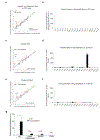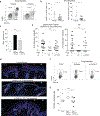Treg-Cell Control of a CXCL5-IL-17 Inflammatory Axis Promotes Hair-Follicle-Stem-Cell Differentiation During Skin-Barrier Repair
- PMID: 30893588
- PMCID: PMC6507428
- DOI: 10.1016/j.immuni.2019.02.013
Treg-Cell Control of a CXCL5-IL-17 Inflammatory Axis Promotes Hair-Follicle-Stem-Cell Differentiation During Skin-Barrier Repair
Abstract
Restoration of barrier-tissue integrity after injury is dependent on the function of immune cells and stem cells (SCs) residing in the tissue. In response to skin injury, hair-follicle stem cells (HFSCs), normally poised for hair generation, are recruited to the site of injury and differentiate into cells that repair damaged epithelium. We used a SC fate-mapping approach to examine the contribution of regulatory T (Treg) cells to epidermal-barrier repair after injury. Depletion of Treg cells impaired skin-barrier regeneration and was associated with a Th17 inflammatory response and failed HFSC differentiation. In this setting, damaged epithelial cells preferentially expressed the neutrophil chemoattractant CXCL5, and blockade of CXCL5 or neutrophil depletion restored barrier function and SC differentiation after epidermal injury. Thus, Treg-cell regulation of localized inflammation enables HFSC differentiation and, thereby, skin-barrier regeneration, with implications for the maintenance and repair of other barrier tissues.
Keywords: CXCL5; IL-17; Lrg5; barrier repair; epidermis; hair follicle stem cells; regulatory T cell (Treg); skin; stem cell.
Copyright © 2019 Elsevier Inc. All rights reserved.
Conflict of interest statement
Figures






Similar articles
-
Regulatory T Cells in Skin Facilitate Epithelial Stem Cell Differentiation.Cell. 2017 Jun 1;169(6):1119-1129.e11. doi: 10.1016/j.cell.2017.05.002. Epub 2017 May 25. Cell. 2017. PMID: 28552347 Free PMC article.
-
CD80 on skin stem cells promotes local expansion of regulatory T cells upon injury to orchestrate repair within an inflammatory environment.Immunity. 2024 May 14;57(5):1071-1086.e7. doi: 10.1016/j.immuni.2024.04.003. Epub 2024 Apr 26. Immunity. 2024. PMID: 38677291 Free PMC article.
-
Glucocorticoid signaling and regulatory T cells cooperate to maintain the hair-follicle stem-cell niche.Nat Immunol. 2022 Jul;23(7):1086-1097. doi: 10.1038/s41590-022-01244-9. Epub 2022 Jun 23. Nat Immunol. 2022. PMID: 35739197 Free PMC article.
-
Development and Maintenance of Epidermal Stem Cells in Skin Adnexa.Int J Mol Sci. 2020 Dec 20;21(24):9736. doi: 10.3390/ijms21249736. Int J Mol Sci. 2020. PMID: 33419358 Free PMC article. Review.
-
Epithelial stem cells and implications for wound repair.Semin Cell Dev Biol. 2012 Dec;23(9):946-53. doi: 10.1016/j.semcdb.2012.10.001. Epub 2012 Oct 17. Semin Cell Dev Biol. 2012. PMID: 23085626 Free PMC article. Review.
Cited by
-
Materials-based hair follicle engineering: Basic components and recent advances.Mater Today Bio. 2024 Oct 18;29:101303. doi: 10.1016/j.mtbio.2024.101303. eCollection 2024 Dec. Mater Today Bio. 2024. PMID: 39498149 Free PMC article. Review.
-
Immune modulation of hair follicle regeneration.NPJ Regen Med. 2020 May 11;5:9. doi: 10.1038/s41536-020-0095-2. eCollection 2020. NPJ Regen Med. 2020. PMID: 32411394 Free PMC article. Review.
-
[Research progress of hair follicle and related stem cells in scar-free wound healing].Zhongguo Xiu Fu Chong Jian Wai Ke Za Zhi. 2021 Feb 15;35(2):241-245. doi: 10.7507/1002-1892.202005086. Zhongguo Xiu Fu Chong Jian Wai Ke Za Zhi. 2021. PMID: 33624481 Free PMC article. Chinese.
-
Jagged-1+ skin Tregs modulate cutaneous wound healing.Sci Rep. 2024 Sep 9;14(1):20999. doi: 10.1038/s41598-024-71512-1. Sci Rep. 2024. PMID: 39251686 Free PMC article.
-
The potential of regulatory T cell-based therapies for alopecia areata.Front Immunol. 2023 May 2;14:1111547. doi: 10.3389/fimmu.2023.1111547. eCollection 2023. Front Immunol. 2023. PMID: 37205097 Free PMC article. Review.
References
Publication types
MeSH terms
Substances
Grants and funding
LinkOut - more resources
Full Text Sources
Other Literature Sources
Molecular Biology Databases
Miscellaneous

